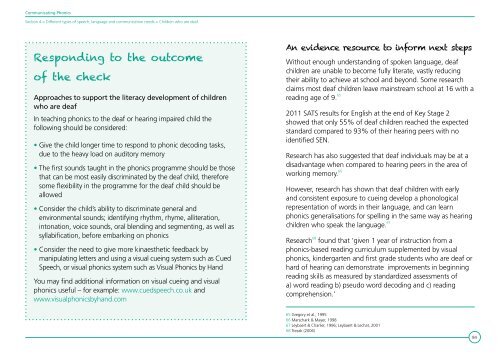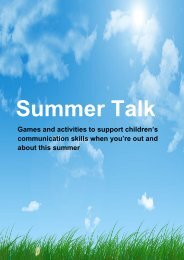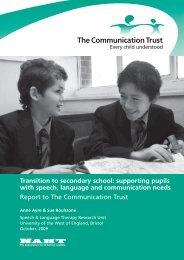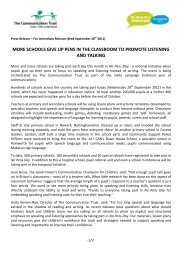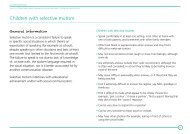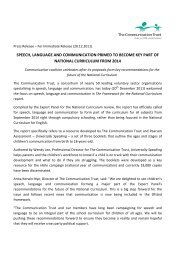Communicating Phonics - The Communication Trust
Communicating Phonics - The Communication Trust
Communicating Phonics - The Communication Trust
Create successful ePaper yourself
Turn your PDF publications into a flip-book with our unique Google optimized e-Paper software.
<strong>Communicating</strong> <strong>Phonics</strong>Section 4 > Different types of speech, language and communication needs > Children who are deafResponding to the outcomeof the checkApproaches to support the literacy development of childrenwho are deafIn teaching phonics to the deaf or hearing impaired child thefollowing should be considered:• Give the child longer time to respond to phonic decoding tasks,due to the heavy load on auditory memory• <strong>The</strong> first sounds taught in the phonics programme should be thosethat can be most easily discriminated by the deaf child, thereforesome flexibility in the programme for the deaf child should beallowed• Consider the child’s ability to discriminate general andenvironmental sounds; identifying rhythm, rhyme, alliteration,intonation, voice sounds, oral blending and segmenting, as well assyllabification, before embarking on phonics• Consider the need to give more kinaesthetic feedback bymanipulating letters and using a visual cueing system such as CuedSpeech, or visual phonics system such as Visual <strong>Phonics</strong> by HandYou may find additional information on visual cueing and visualphonics useful – for example: www.cuedspeech.co.uk andwww.visualphonicsbyhand.comAn evidence resource to inform next stepsWithout enough understanding of spoken language, deafchildren are unable to become fully literate, vastly reducingtheir ability to achieve at school and beyond. Some researchclaims most deaf children leave mainstream school at 16 with areading age of 9. 652011 SATS results for English at the end of Key Stage 2showed that only 55% of deaf children reached the expectedstandard compared to 93% of their hearing peers with noidentified SEN.Research has also suggested that deaf individuals may be at adisadvantage when compared to hearing peers in the area ofworking memory. 66However, research has shown that deaf children with earlyand consistent exposure to cueing develop a phonologicalrepresentation of words in their language, and can learnphonics generalisations for spelling in the same way as hearingchildren who speak the language. 67Research 68 found that ‘given 1 year of instruction from aphonics-based reading curriculum supplemented by visualphonics, kindergarten and first grade students who are deaf orhard of hearing can demonstrate improvements in beginningreading skills as measured by standardized assessments ofa) word reading b) pseudo word decoding and c) readingcomprehension.’65 Gregory et al., 199566 Marschark & Mayer, 199867 Leybaert & Charlier, 1996; Leybaert & Lechat, 200168 Trezak (2006)84


